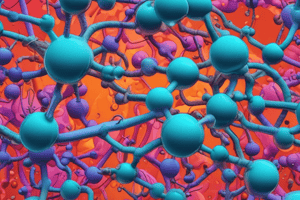Podcast
Questions and Answers
What does Dalton's law state regarding the behavior of gases in a mixture?
What does Dalton's law state regarding the behavior of gases in a mixture?
- The total pressure equals the sum of partial pressures. (correct)
- The concentration of a gas in a liquid is influenced by its temperature.
- The pressure exerted by a gas is independent of its volume.
- A gas will exert pressure only in the presence of other gases.
How does Henry’s law describe the relationship between a gas and its concentration in a liquid?
How does Henry’s law describe the relationship between a gas and its concentration in a liquid?
- Concentration is independent of the gas's partial pressure.
- Concentration is reduced when temperature increases.
- Concentration decreases with increased volume of the liquid.
- Concentration is proportional to the partial pressure of the gas. (correct)
What impact does a decrease in tidal volume have on minute ventilation?
What impact does a decrease in tidal volume have on minute ventilation?
- It results in decreased carbon dioxide elimination. (correct)
- It leads to an increase in respiratory rate.
- It increases minute ventilation without affecting gas exchange.
- It enhances oxygen transport efficiency.
Which clinical tools are used to display expiratory flow rates and volumes?
Which clinical tools are used to display expiratory flow rates and volumes?
What does the spirogram display in regard to respiratory function?
What does the spirogram display in regard to respiratory function?
What is primarily affected by the manipulation of blue colored balls according to the text?
What is primarily affected by the manipulation of blue colored balls according to the text?
Which factor can lead to inaccuracies in monitoring lung volumes?
Which factor can lead to inaccuracies in monitoring lung volumes?
What crucial relationship between tidal volume and minute ventilation is highlighted?
What crucial relationship between tidal volume and minute ventilation is highlighted?
Which of the following correctly defines Tidal Volume (TV)?
Which of the following correctly defines Tidal Volume (TV)?
What is the significance of the Residual Volume (RV) in pulmonary function?
What is the significance of the Residual Volume (RV) in pulmonary function?
Which condition must be fulfilled for proper ventilation concerning the airway?
Which condition must be fulfilled for proper ventilation concerning the airway?
In analyzing respiratory disorders, which element is primarily focused on rather than oxygenation?
In analyzing respiratory disorders, which element is primarily focused on rather than oxygenation?
What does Forced Expiratory Volume in 1 second (FEV1) measure?
What does Forced Expiratory Volume in 1 second (FEV1) measure?
What is the effect of stimulating efferent vagal fibers on airway resistance?
What is the effect of stimulating efferent vagal fibers on airway resistance?
Which agents are known to cause airway constriction when released by resident cells?
Which agents are known to cause airway constriction when released by resident cells?
What physiological response is triggered by the inhalation of smoke or cold air?
What physiological response is triggered by the inhalation of smoke or cold air?
What best describes residual volume in the respiratory system?
What best describes residual volume in the respiratory system?
Which statement accurately defines vital lung capacity?
Which statement accurately defines vital lung capacity?
What impact does stimulation of sympathetic nerves have on airway constriction?
What impact does stimulation of sympathetic nerves have on airway constriction?
What effect does an increase in gas density have on airway resistance?
What effect does an increase in gas density have on airway resistance?
Which statement accurately describes tidal volume?
Which statement accurately describes tidal volume?
Which component is NOT involved in causing airway constriction?
Which component is NOT involved in causing airway constriction?
Which factor is crucial for maintaining the patency of the alveoli and terminal airways?
Which factor is crucial for maintaining the patency of the alveoli and terminal airways?
What is a characteristic of obstructive pulmonary disease?
What is a characteristic of obstructive pulmonary disease?
What is the purpose of breathing a low-density gas like oxygen-helium?
What is the purpose of breathing a low-density gas like oxygen-helium?
How does edema contribute to respiratory function?
How does edema contribute to respiratory function?
Which of the following is NOT a factor that decreases the caliber of the airways?
Which of the following is NOT a factor that decreases the caliber of the airways?
What characterizes Expiratory Reserve Volume (ERV)?
What characterizes Expiratory Reserve Volume (ERV)?
Which condition can exacerbate problems caused by increased airway resistance?
Which condition can exacerbate problems caused by increased airway resistance?
What does inspiratory reserved volume represent?
What does inspiratory reserved volume represent?
In the context of total lung capacity (TLC), which statement is true?
In the context of total lung capacity (TLC), which statement is true?
How is the primary difference defined between a volume and a capacity in respiratory terms?
How is the primary difference defined between a volume and a capacity in respiratory terms?
What effect do allergens and viral infections have on airway resistance?
What effect do allergens and viral infections have on airway resistance?
Which of the following statements about methacholine is accurate?
Which of the following statements about methacholine is accurate?
Which statement best describes the impact of breathing frequency on total lung capacity?
Which statement best describes the impact of breathing frequency on total lung capacity?
Which component is NOT essential in the definition of airway hyperresponsiveness?
Which component is NOT essential in the definition of airway hyperresponsiveness?
What characterizes the behavior of neutrophils and eosinophils in the respiratory system?
What characterizes the behavior of neutrophils and eosinophils in the respiratory system?
Flashcards are hidden until you start studying
Study Notes
Gas Laws and Their Implications
- Dalton’s Law describes the concept of partial pressure in gas mixtures; each gas exerts pressure independently as if it occupied the total volume alone.
- Henry’s Law relates the concentration of dissolved gases in liquids to their partial pressures, establishing a direct proportionality.
Lung Volume and Gas Exchange
- Alveolar oxygenation plays a crucial role in gas exchange, often highlighted in contrast to the process of ventilation.
- Tidal volume, the amount of air exchanged in quiet breathing, can be influenced by external factors, such as changes represented by color-coded balls in experimental settings.
- Minute ventilation is significantly impacted by alterations in tidal volume and frequency of breathing, affecting carbon dioxide elimination.
Lung Capacity Measurements
- Clinical evaluation of respiratory health involves measuring expiratory flow rates and lung volumes, crucial for diagnosing and monitoring pulmonary diseases. Results can be visualized via:
- Spirogram: Displays gas volume exhaled over time.
- Flow-volume curve/loop: Illustrates the flow of air during the breathing cycle.
- Key measured values include:
- Forced Vital Capacity (FVC): Total air expelled during forced exhalation.
- Residual Volume (RV): Air remaining in the lungs post-exhalation.
Ventilation Mechanics
- Efficient thoracic pump mechanisms are necessary for effective alveolar expansion and ventilation.
- Airway obstruction impedes air passage, affecting gas exchange efficiency.
- Disorders affecting ventilation should primarily assess carbon dioxide elimination rather than solely focusing on oxygenation.
Work of Breathing
- The work of breathing refers to the effort needed to overcome lung resistance and facilitate airflow into and out of the lungs.
- Factors such as airway mucus, edema, and bronchial smooth muscle contraction can increase airway resistance, complicating respiration.
- Breathing low-density gases (e.g. oxygen-helium mixtures) can reduce airway resistance, beneficial in treating obstructive airways diseases.
Neurohumoral Regulation
- Efferent vagal nerve stimulation leads to increased airway resistance, while sympathetic activation causes bronchodilation, reducing resistance.
- Reflex responses to irritants (smoke, cold air) often result in airway constriction and coughing, a protective mechanism.
- Various substances (e.g., histamine, leukotrienes) play roles in modulating airway resistance during allergic or inflammatory responses.
Key lung volume definitions
- Tidal Volume (TV): Air volume inhaled/exhaled during normal breathing.
- Inspiratory Reserve Volume (IRV): Additional air that can be inhaled beyond TV.
- Expiratory Reserve Volume (ERV): Extra air exhaled after normal expiration.
- Total Lung Capacity (TLC): Maximum volume of air the lungs can hold after maximal inhalation.
Distinguishing Volumes and Capacities
- A capacity is the combination of two or more lung volumes, while a volume measures a specific air quantity without considering any combination.
Studying That Suits You
Use AI to generate personalized quizzes and flashcards to suit your learning preferences.




